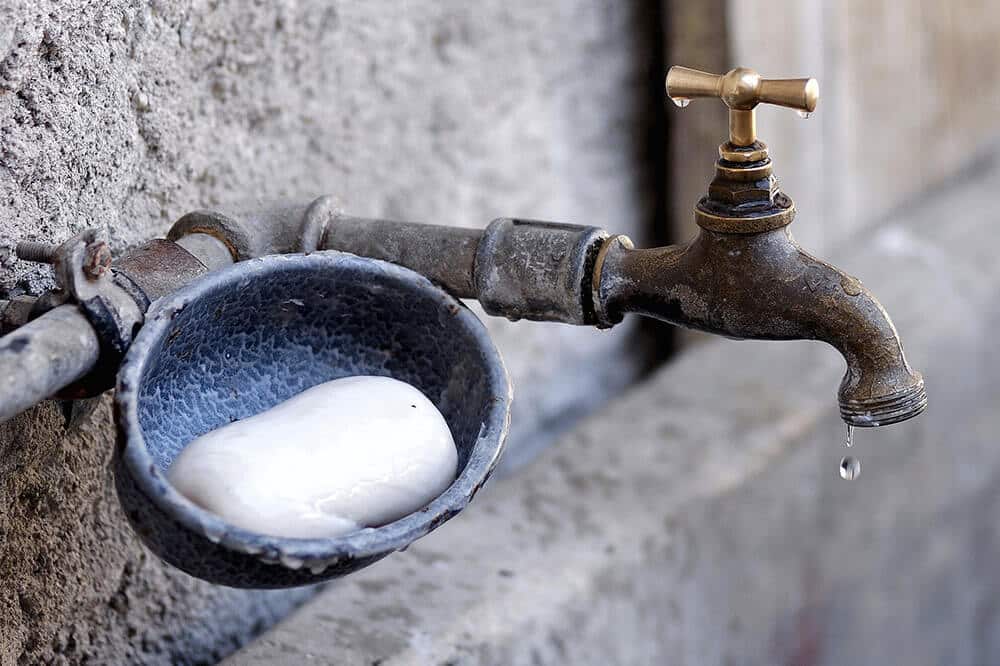There it was, sitting on the edge of my palette…
…my favorite sable hair bristle brush…
…coated in burnt umber that I used for an underpainting.
As I just wrapped up this layer for a portrait that I was working on, I got distracted…
…yes, I started to hastily work on the overpainting.
I don’t know why I started so quickly.
But I do remember it was late and I just figured it would be a great way to end the evening before I headed off to bed.
Needless to say, I came down to my studio the following morning.
There it was staring at me…
…my beloved sable brush that I had since art school (funny how we develop relationships with inanimate objects), was hard as a rock!
I completely forgot to wash the brush before I headed to bed the previous night.
Needless to say, I was devastated.
But not ready to give up so easily!
Like any artist in a similar situation, I headed to Google and searched:
How to get dried acrylic out of sable brushes…
Let’s just say this:
The answers were lacking!
So, I had to get inventive and take things into my own hands.
Which brings me to today’s article where we will try our very best to resuscitate a hardened acrylic-coated paint brush.
But before we go into all the details on how to get dried acrylic paint out of your brushes, I first want to add this note:
Think of this as a rescue mission at best.
More often than not, brushes that had acrylic paint dried on them may be far too damaged.
So with that, these are tips that may be able to help you.
Every scenario is different (bristle, coating, etc.) and we don’t want to provide you with false promises that your brush will be like new again…

Table of Contents
What Type Of Bristle Is On Your Brush?
While we won’t go over all the different bristles found on paint brushes, they largely fall into two categories – natural and synthetic.
Here’s what you should know if you are trying to remove hardened acrylic from either one of these bristle types:
Synthetic Bristles
More often than not, when it comes to synthetic bristles, these brushes are largely a lost cause when trying to remove old acrylic paint.
Unlike natural fibers that can be treated with differing solutions (more on this in a minute), synthetic brushes will often dissolve or break down significantly when exposed to harsh chemicals.
While you can definitely try some of the solutions we outline below, we would just exercise caution as they will likely not yield terrific results.
Natural Fibers
Whether you are using hog, badger, squirrel, or sable/kolinsky brushes, you have a much greater chance at removing dried acrylic.
As you probably have guessed, these natural fibers are much more resilient to some of the harsh chemicals that work to remove acrylic.
Here’s a quick suggestion:
If you find yourself using acrylic as a medium often, we would recommend that you invest in only natural fiber brushes.
While typically a tad bit more expensive that your synthetic brushes, your options when it comes to cleaning AND mediums will pay dividends throughout your journey as an artist.
We would recommend checking out retailers like Dick Blick as they often have special offers when you buy en masse.
Solutions That Have Helped Artists Remove Dried Acrylic From Paint Brushes
Here are there common items that work wonders to fully remove stubborn dried acrylic:
Acetone
A common ingredient found many medicine cabinets, acetone is the active ingredient in nail polish removers.
A solvent in its own right, acetone should help to deeply penetrate the brush bristles and dissolve any of the acrylic buildup.
As you are likely aware, acetone has strong scent and should be used in a well-ventilated area and away from children.
Isopropyl Alcohol
An alternative to acetone and one that will carry significantly less odor will be Isopropyl Alcohol.
Delivering the same effects as acetone, alcohol will work to penetrate and dissolve the acrylic paint buildup.
This same ingredient is found in formal ‘Acrylic Removers’ online. Therefore, you won’t want to waste your money buying one of these as they are just simply repackaged and resold under another name.
You can verify this by reading the MSDS information related to the product.
Directions On Using Acetone or Alcohol
Whether your solvent of choice is acetone or alcohol, the steps to remove the dried paint will be identical.
You will want to do the following:
Pour your acetone or alcohol into a glass jar (just enough to fully cover the bristles and ferrule) and let your brush soak for a couple of minutes.
After the time has elapsed, you will then want to wash thoroughly with warm soapy water.
We recommend using a dishwashing detergent as it will be able to penetrate the bristles deeper than a standard hand soap.
If the acrylic clumps remain in the bristles, then you want to repeat the above process until the brush is free of any debris.
Hand Sanitizing Gel
Sure, hand sanitizing gel will be a great way to clean your hands when a proper hand soap and sink isn’t readily available, however, when it comes to removing acrylic paint from your favorite brush it can be a pretty effective solution as well.
Hand sanitizing gel differs slightly from the Isopropyl Alcohol solution that we presented above.
Instead, this product often relies on a slightly different alcohol chain (ethyl alcohol), but will deliver nearly identical results.
Some artists may prefer this solution over acetone or isopropyl alcohol as you can simply squire a bit of the hand sanitizing gel into the palm of your hand and rub the brush thoroughly to clean.
Just like the dip method we outlined above, with hand sanitizing gel you will only want to expose the bristles to the alcohol for a couple of minutes at most and then wash with warm soapy water.
Repeat the process until all the clumps of the acrylic paint are fully removed.

Other Tips And Tricks To Remove Acrylic From A Brush Before You Give Up Hope
Here are a few last-ditch efforts that you can use on your brush should any of the above methods are just simply not achieving the results you are looking for:
Old Comb For Physical Removal
If you have a cheap comb or one that you just simply don’t find yourself using any more, you may be able to use this to physically remove any acrylic paint bits.
The finer the teeth on the comb, the better the results will be.
In order to prevent any accidental breakage on the bristles or even pulling them out from the ferrule of the brush, you will want to make sure that you firmly hold the bristles towards the base (near the ferrule).
This should help keep nearly all the bristles intact as you run the comb through the brush.
Note: We wouldn’t recommend that you attempt using this method on a dry brush as it will likely cause fraying of the bristles.
Instead, you will want to wet the brush or add a drop or two of linseed oil. This will help strengthen the bristles and allow the paint to slide off a bit more easily and you should be able to successfully knock it free.
Giving Your Brush A Haircut
The last option that you have at your disposal is to simply trim the brush.
While this will largely destroy the brush on many levels, you may have other uses for your damaged brush in your studio (i.e. stippling).
Secondly, if you have any little ones in your home or any nieces, nephews, or grandchildren, they likely aren’t going to take notice of the bristle shapes and will be ecstatic at getting a real paint brush – especially from an artist like yourself 🙂

Have An Honest Debrief With Yourself
Ever hear the saying ‘we are our own worst critic’…
…Perhaps the person who coined this term was an artist themselves…
…however, I feel like this is completely applicable in what we covered today.
In order to prevent this problem from affecting any more of your paint brushes in the future, it’s important that you take just a minute or two to really examine your workflow and cleanup process.
Here are a few things that we identified within our own studio that is sure to be applicable for many of our readers:
Always Have Water Handy
As many of you are likely aware, acrylic is water soluble. This means that when its dipped into water, the paint will break apart.
Therefore, you will want to always have at least one jar within your immediate work area at all times.
While some artists like to employ the double bath method (pre-rinse and deep rinse), just simply having one jar of water will help to preserve your brushes.
Tip: Just be careful not to store your brushes in the jars of water overnight as it will cause the bristles to become bent.
Keep Yourself On A Schedule
Setting some self-discipline around your workflow may help you keep both your momentum when painting while also preserving your brushes for years.
For the folks who like to keep a tight schedule we would recommend relying on a timer.
While you should still be placing your brushes in a jar of water when they aren’t in use, you should build in a break every hour during painting.
We would recommend this for a few reasons:
First, it gives you time to go and clean out your brushes to ensure that there is no acrylic buildup in either the tips or at the base near the ferrule.
This will not only give you a fresh set of paint brushes again so you have vivid colors when you return to the painting, but also will help in the long-term preservation of your brushes.
Secondly, these built in short breaks every hour will help to get your blood flowing should you have been sitting the entire time. This will ultimately help you to be more creative and take a moment to collect your thoughts.
Some of our very best ideas occur when we take a second look at the painting from afar and decide on how to approach our next hour.

Examining Your Washing Habits
Ok, I’ll be honest:
I am incredibly bad at washing the acrylic paint buildup that is near the ferrule.
Whether it’s being a tad bit too lazy or simply glossing over the part when washing, for one reason or another it’s an area that I really need to work on when cleaning a brush.
Therefore, it might be worth taking a look at your dried brushes currently sitting in your studio that have been used with acrylics.
Do you notice any patterns where you keep on missing out during the cleaning process?
Is your ferrule loaded with left over acrylic paint?
Or is the center of the bristles really looking in poor shape?
Whatever the case may be for you, a simple 10 second evaluation may give you some insight into your washing habits of your paint brushes and where you could improve.
Closing Thoughts On Brush Preservation And Cleaning
While all the above methods are effective at cleaning out a paint brush with dried acrylic paint, it bears repeating that these aren’t necessarily always going to work.
Hardened acrylic paint is terribly difficult to remove and these methods should only be employed as a last best effort before your beloved brushes end up in the trash.
Therefore, it’s worth reinforcing again, that repeated and thorough washing of the paint brushes during and after every time you paint with acrylics is paramount.
Don’t take shortcuts on the cleaning process, your brushes depend on you!